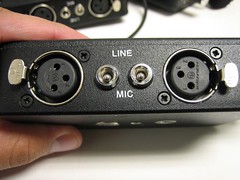Explain all those cables and connectors on a mixing board, please
Permalinks to this entry: individual page or in monthly context. For more material from my journal, visit my home page or the archive.
 Yesterday I dropped in to see Roland and we got to discussing mobile podcasting. I gave him a bit of a brain dump of what I know about audio engineering and recording, which isn't a whole ton (more like half a ton), and here's what I sent him afterward.
Yesterday I dropped in to see Roland and we got to discussing mobile podcasting. I gave him a bit of a brain dump of what I know about audio engineering and recording, which isn't a whole ton (more like half a ton), and here's what I sent him afterward.
General resources
I've heard that Audio Made Easy is a fantastic book to start with, and it's on my Amazon wish list.
IT Conversations recorded an excellent talk from the Podcast Academy on portable podcasting. It has a wiki too.
Gear
In addition to those I recommended in my posts to TidBITS, here are some more links about microphones and stuff:
- Lavalier mics: At the Editors' Association of Canada we use this model, and there is another inexpensive option too.
- Boundary microphones: The Source calls this model a "meeting microphone," so it might be good.
- Portable package: Here's what the guys from PWOP (home of Mondays, which includes my old friend Richard Campbell) recommend for getting a good sound from an iRiver MP3 recorder. A very useful resource.
- Here's a fabulous small mixer.
Connectors and cables
Some info about different connector and cable types:
- Connector Types
- An Explanation of Balanced Cabling
- Balanced vs. Unbalanced Cabling
- Wikipedia has a good explanation of the different kinds of microphones.
Here are all the different connector types you're likely to run across (at least that I could think of). For mics, you're generally only concerned with XLR, Neutrik Combo, 1/4" TRS, 1/4" mono, and 1/8" stereo connectors. Phantom power for condenser mics generally only comes from the XLR or Neutrik Combo connectors, or from an onboard battery as in the borrowed AKG C1000S I often use.
- XLR (standard for pro mics):
- Neutrik Combo (accepts balanced mic with XLR converter, or unbalanced plugged straight in the middle)
- 1/4" TRS (Tip-Ring-Sleeve) Phono mono balanced OR stereo unbalanced (also called standard stereo headphone)
- 1/4" Phono mono unbalanced (like a guitar cable)
- 1/8" Stereo (mini-headphone or mini-stereo, like your iPod or Walkman)
- RCA (standard for stereos)
- USB Type A (like on your computer) or Type B (like on a USB hub or device)
- FireWire 6-pin (a.k.a. FireWire 400 6-pin, like on your Mac, IEEE-1394)
- FireWire 4-pin (a.k.a. FireWire 400 4-pin) smaller, unpowered, also called Sony iLink)
- FireWire 800 (different shape, adapter required to connect to slower-but-still-very-fast FireWire 400 ports or cables)
- Speakon (locking, for powered speaker lines)
- Coax (standard cable TV, old-style Ethernet)
- RJ-45 (10BaseT, 100BaseT, 1000BaseT "Gigabit" Ethernet)
- Optical/SPDIF/Toslink (SPDIF can also use RCA connectors)
- MIDI DIN (MIDI can also go through USB)
You can also get an adapter like the MicPlug that goes directly from XLR to USB. I have one, it runs on USB power, and it works pretty well. There is a similar GuitarPlug that uses 1/4" mono to plug into a guitar instead of XLR to plug into a microphone.







